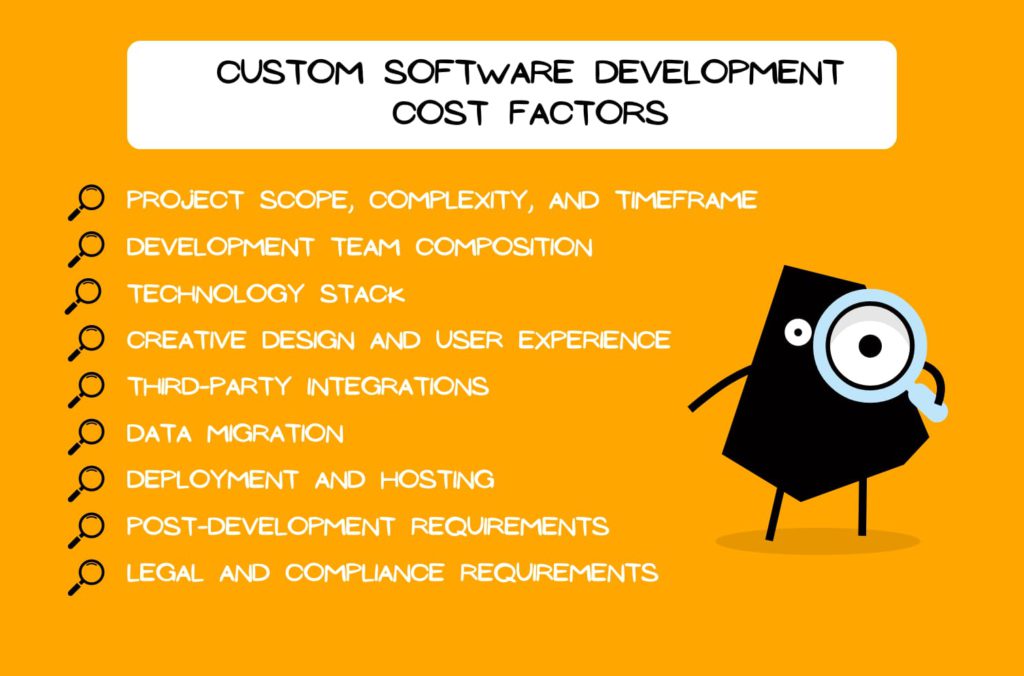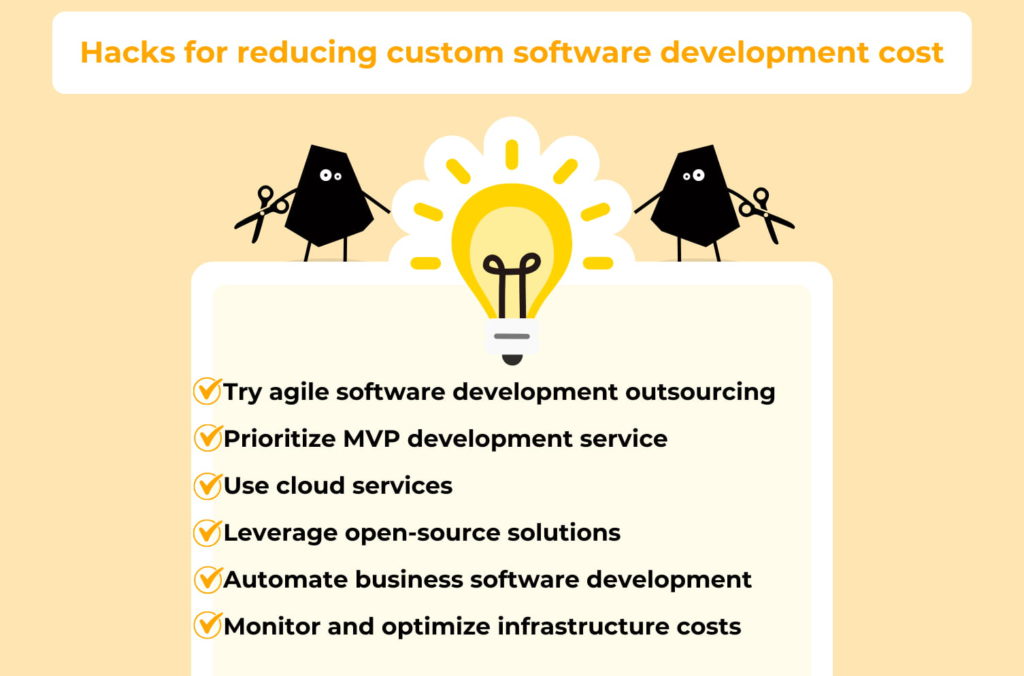Hacks for reducing software development costs

A penny saved is a penny earned. Even in your efforts to develop customer software, you can save money. Finding ways to cut software development costs without sacrificing quality can be tricky, but possible. By identifying inefficiencies and implementing strategic approaches, you can achieve significant savings while still delivering a high-quality product. Let’s see the average prices for it first.
How much does custom software development cost?
Some interesting figures: In our experience, MVP and small applications might cost you up to $100,000 with a duration of approximately 4-6 months. Medium applications are within the range of $100,000 to $200,000 with a duration of about 8-10 months, while medium-sized applications are around $200,000+ with deadlines of 10+ months. Large and complex applications might reach far more than $400,000.
As we can see, the price mainly depends on the project’s complexity and its duration. The secure software development lifecycle is notorious for being resource-intensive, involving extensive time, effort, and financial investment. By employing smart strategies and leveraging our tips, you can streamline processes, enhance efficiency, and ultimately reduce expenses. This article is about the latter one.
Reduce software development costs with our pro dev team
What are custom software development cost factors?
After we have figured out the average software development price, let’s consider factors that impact it. To that end, we took several key factors that influence the cost of software development. Understanding these factors can help you better estimate expenses and identify potential areas for cost savings. And, as mentioned above, the first point goes to:

1. Software development project scope, complexity, and timeframe
- Scope: The more features and functionalities your software requires, the higher the cost. Detailed requirements and extensive features demand more development time and resources.
- Complexity: Complex algorithms, integrations with other systems, and advanced technologies like AI or blockchain can increase costs significantly.
- Timeframe: Tight deadlines might require more developers or longer working hours, both of which can increase costs. Conversely, a more flexible timeline might allow for cost savings through better planning and resource allocation.
2. Development team composition
- Team size and expertise: The number of developers and their level of expertise directly impact costs. Specialized skills, such as data science or cybersecurity, often come at a premium.
- Geographical location: Rates vary by region. For example, developers in North America or Western Europe typically charge more than those in Eastern Europe or Asia.
3. Technology stack
The choice of programming languages, frameworks, and tools can affect development speed and cost. Some technologies might require more expensive licenses or have a steeper learning curve.
4. Creative design and user experience
A well-designed UI/UX is crucial for user adoption but can be costly. Custom designs, animations, and user testing add to the overall expense.
5. Third-party integrations
Integrating third-party services (e.g., payment gateways, CRM systems) can increase development time and costs, especially if extensive customization or API work is needed.
6. Data migration
Integrating and migrating data from legacy systems or different databases can be a complex and time-consuming process. The cost of data migration depends on the volume of data, the condition of existing data, and the complexity of the transformation needed to fit the new system.
- Data volume: Larger volumes of data require more time and resources to migrate, which can increase costs. Efficient data integration tips and robust planning can help mitigate some of these expenses.
- Data quality: Poor-quality data may require extensive data cleaning and validation before migration. This process ensures that only accurate and relevant data is transferred, but it can add significant labor costs.
- Transformation requirements: Data often needs to be transformed to match the format and structure of the new system. The complexity of these transformations, especially if custom scripts or tools are required, can significantly impact the overall cost.
- Downtime management: Minimizing downtime during data migration is crucial to maintaining business operations. Developing strategies to handle data migration with minimal disruption can incur additional costs but is essential for ensuring business continuity.
7. Deployment and hosting
- Infrastructure costs: Costs for servers, cloud services, and other infrastructure shall be considered here.
- Deployment complexity: More complex deployment scenarios, such as those involving multiple environments (development, staging, production), can increase costs.
8. Post-development requirements
- Maintenance and support: Ongoing maintenance, post-launch support, bug fixes, and updates are ongoing costs that need to be factored into the overall budget.
- Testing and quality assurance: Rigorous testing for bugs, security issues, and performance is essential to ensure a bug-free product. More comprehensive testing processes require more time and resources.
9. Legal and compliance requirements
Compliance with industry standards (e.g., GDPR, HIPAA) often requires additional development effort and can increase costs due to the need for specialized knowledge and rigorous testing.
Hacks for reducing custom software development cost
Implementing strategies to cut software development costs without compromising quality is crucial. Whether you’re a startup with limited funds or an established company looking to optimize your budget, there are several effective hacks to help you achieve the balance between cost efficiency and high-quality software development. We gathered some for you.

1. Try agile software development outsourcing
In order for you not to redo something related to business software development, it’s worth embracing agile methodology with its iterative and incremental approach. By breaking the project into smaller, manageable chunks and continuously evaluating the results, you can adapt quickly to changes and avoid costly rework.
Adopting agile methodologies while outsourcing can significantly reduce costs and improve project flexibility and responsiveness, resulting in significant software development cost reduction. Agile practices allow for iterative development, continuous feedback, regular adjustments, and early issue identification.
2. Prioritize MVP development service
Whether you are validating a startup or new product idea, focus on developing a Minimum Viable Product (MVP) first. This approach allows you to test the core functionalities and gather user feedback before investing in additional features. It helps avoid unnecessary spending on features that users may not need.
3. Use cloud services
Opt for cloud-based infrastructure and services to minimize the costs associated with maintaining physical servers and data centers. Cloud platforms offer scalable solutions that can grow with your project, reducing initial expenses.
As an AWS Select Consulting Partner, we root for AWS services. AWS offers a range of powerful tools and services that are both cost-effective and scalable, allowing you to pay only for what you use and easily adjust resources as your needs change.
Plus, cloud development outsourcing will work for you. This solution can help you to scale your development efforts quickly, without incurring the overhead costs associated with on-premises infrastructure and in-house teams.
4. Leverage open-source solutions
Avoid the expense of building solutions from scratch, save on licensing fees, and reduce development time by utilizing open-source libraries, frameworks, and tools. Many open-source tools are highly reliable and widely used in the industry, providing robust solutions without the associated costs.
5. Automate business software development
Automation can streamline repetitive tasks, reduce human error, and free up the dev team to focus on more complex problems. This includes automated testing, continuous integration/continuous deployment (CI/CD), and infrastructure as code (IaC).
- Testing: Implement automated testing to quickly identify and fix bugs and streamline the testing process. Automated tests can quickly identify bugs and issues, reducing the need for extensive manual testing and ensuring a robust and reliable codebase.
- CI/CD Pipelines: CI/CD practices streamline the development and deployment process, reducing the time spent on manual deployments and integrations. This approach helps in identifying and fixing issues early, preventing costly delays, and speeding up delivery.
- IaC: It involves managing and provisioning computing infrastructure through machine-readable scripts rather than manual processes. This method allows for scalable environments, consistent and repeatable configurations, which can significantly reduce setup and management costs.
6. Monitor and optimize infrastructure costs
Regularly review your infrastructure usage and costs to identify areas for optimization. Use tools to monitor cloud resource utilization and eliminate unused or underutilized resources. Implement cost-saving measures such as right-sizing instances, using reserved instances, and leveraging spot instances where appropriate.
Conclusion: maximizing efficiency while minimizing software development cost
Whether it’s through agile methodologies, MVP development, cloud services, or automation, the said techniques are aimed at ensuring a more efficient and streamlined development process and achieving cost savings. Prioritizing efficiency and thoughtful planning throughout the development lifecycle allows you to balance budget constraints with the need for robust, reliable software.
You can significantly lower your expenses while maintaining high standards of software performance and functionality. By being proactive and strategic in your approach, you can achieve a balance between cost-efficiency and the quality of your software, ultimately driving better outcomes for your business.





